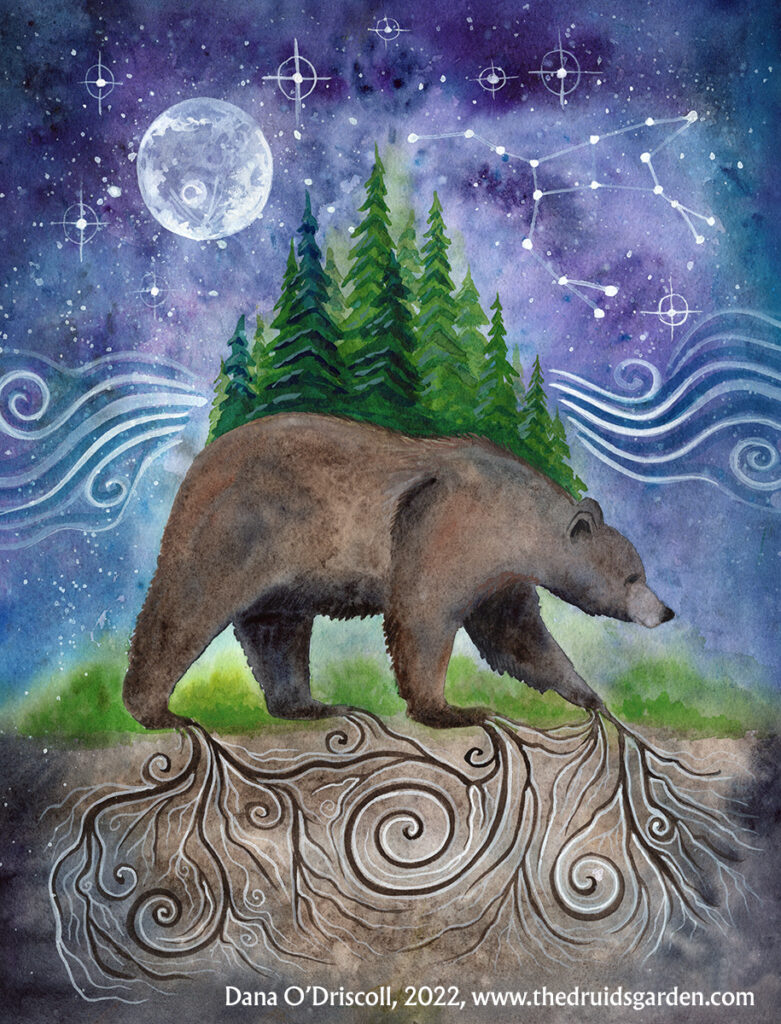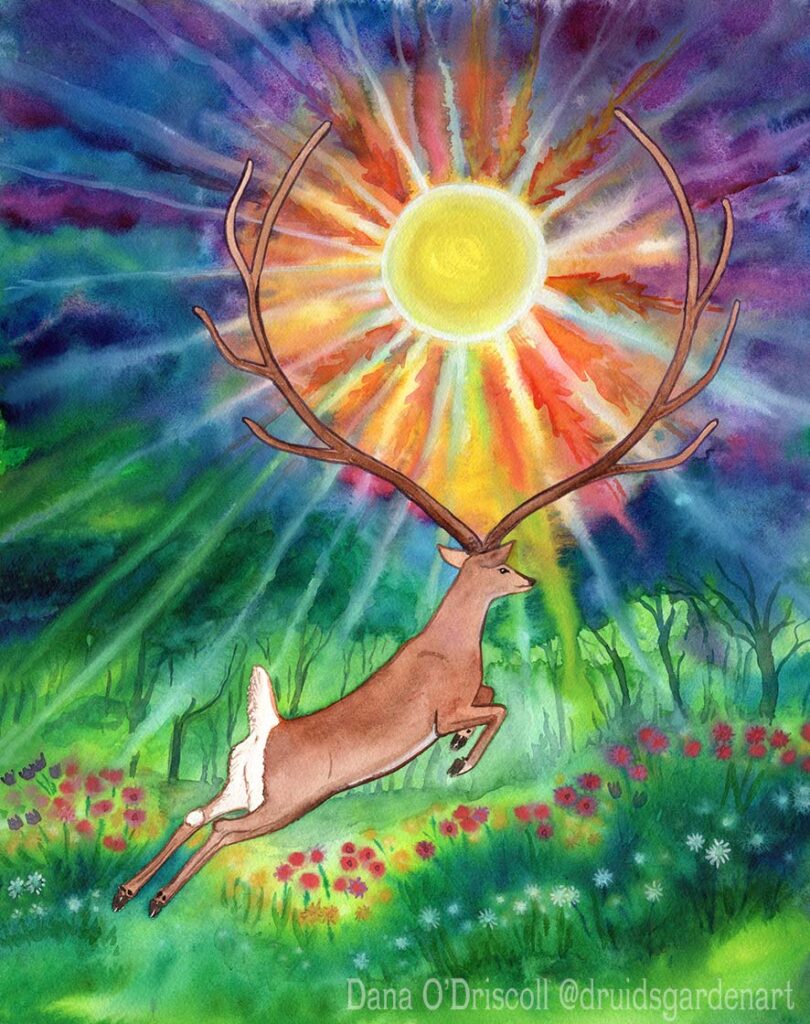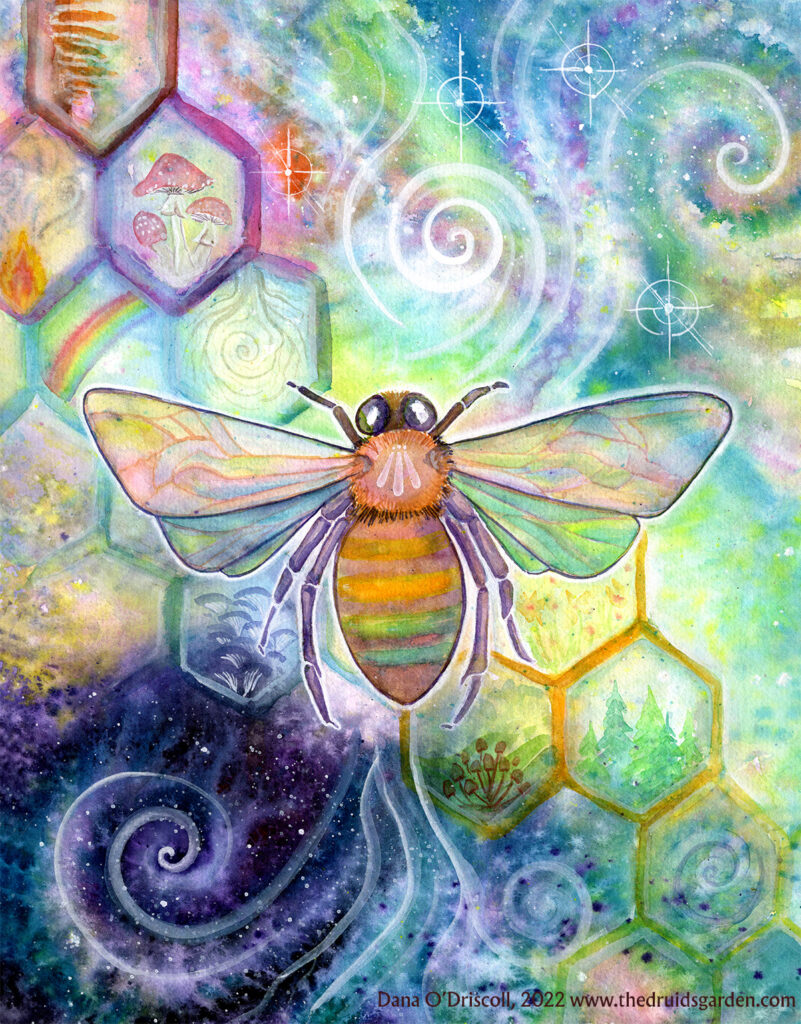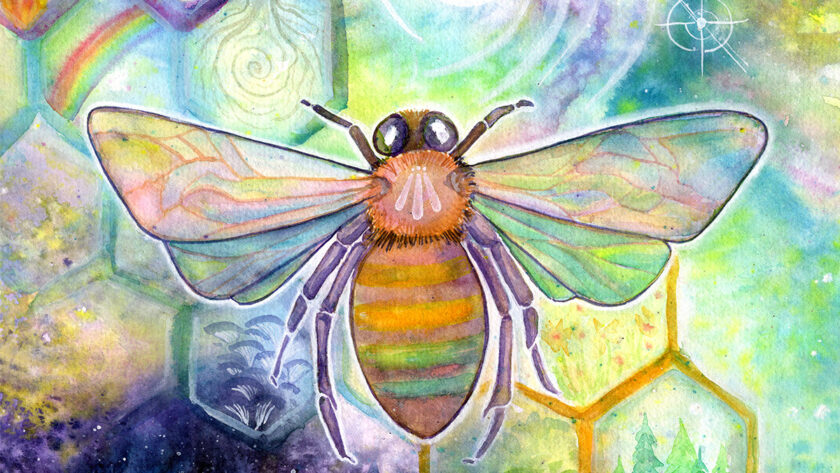In the druid tradition, in multiple modern druid orders, we associate animals or fish with the four directions. The classic ones are:
- The Great Bear in the North
- The Hawk in the East
- The Stag in the South
- The Salmon in the West
Depending on the tradition, it might get a little fancier. For example, in OBOD and AODA, we do some variety of this:
- The great bear of the starry heavens
- The hawk of May soaring in the air
- The white stag in the heat of the chase
- The salmon of wisdom in the sacred pool
And a lot of people who are new to the druid path wonder–where do these sacred animals come from? From the druid revival? From Celtic mythology? From something much older? In fact, all of these animals and sacred symbolism are quite ancient indeed. I wanted to take the time today to share about each of them.
A bit of background here–I began working on a series of paintings about a year ago (which are shared in this post) depicting the four sacred animals in the druid tradition. My goal was to make grove banners or wall hangings for those who were learning the druid tradition. In order to effectively channel this energy, I decided to start to study not only the mythology tied to the Celtic lands, but to see what else was out there….this turned into a very rich and fruitful pursuit. While I was aware of the Celtic connections from my studies in druidry, tracing some of these back much further turned out to be rich and valuable. So for each of these, I offer my finished painting as well as the animals themselves and an overview of the research I did to see how far back I could trace each of these sacred beings. I also strongly felt led to bring a 5th natural being in for the world of spirit, so I’ve also added the “bee of spirit” to the mix. So let’s enter the sacred grove of the druids and meet each of the animals of the druid tradition.
The Great Bear in the North representing the Earth Element
 When you look up at the heavens in the Northern Hemisphere, you see Ursa Major, the big dipper, also known as the Great Bear of the Starry Heavens. Ursa Major was one of the 48 constellations listed by the Roman Astronomer and Scientist Ptolemy in the 2nd century A.D. and is the third largest constellation in the sky, making the Great Bear a powerful symbol that everyone sees.
When you look up at the heavens in the Northern Hemisphere, you see Ursa Major, the big dipper, also known as the Great Bear of the Starry Heavens. Ursa Major was one of the 48 constellations listed by the Roman Astronomer and Scientist Ptolemy in the 2nd century A.D. and is the third largest constellation in the sky, making the Great Bear a powerful symbol that everyone sees.
A growing body of archeological evidence indicates that bear worship can be traced back to the Paleolithic times: the Neandertals, a sub-species of humans who went extinct about 40,000 years ago, worshipped or held bears in reverence through “cave bear” cults. This evidence comes from a variety of sources, including cave paintings, bones, and evidence of a close relationship. Janhuenen (2003) describes the “circumpolar bear cults” or a ring of bear cults that surround the north pole where the bear is elusive, and viewed as a competing hunter, but not harmful to human society. Janhuenen says that these are likely because the bear has human-like qualities (such as the ability to stand, its size, skeletal structure, footprint, and diety habits) as well as the magical ability to hibernate in winter. The mythology surrounding the widespread circumpolar bear cults with refers to larger sets of beliefs prevalent in high-latitude northern areas around the world that can be traced back to Palaeolithic hunting societies. The features of belief include seeing the bear as a supernatural being, the lord of the animals, who can grant hunting boons to human society if properly honored. Because the bear is so powerful, a number of taboos can be associated with the bear including using special language, regulating when it is acceptable to kill a bear, how a killed bear should b treat, or even treating humans who have had bear visions differently.
A bounty of evidence shows that bear worship, bear cults, and bear deities continued to persist into more modern times, and are also very well documented. In ancient Gaul we have Artos, ‘bear’ who is a goddess, tied to the proto-Indo European word “h₂ŕ̥tḱos” bear–this name may also tie to King Arthur (Arto-rix) or “bear king”. The goddess Artio sculpture, from the Muri Statuette Group, found in 1982 in Bern, Switzerland, represents the only known depiction of Artio (See it here).
Eastern Slavic traditions include Volos or Veles, a deity of earth, water, livestock, and the underworld, who is often depicted in a beast form as a bear or wolf, or in a chimera form of a bear combined with a snake. Velos’ symbol is the bear paw, the Seal of Veles, which is a symbol of power. Many peoples of Eastern Russia had bear as a powerful shamanic ally and used bears as some of their primary religious symbolism, including the Ket and Nivkh people. The Nivkh traditionally captured and raised a bear for several years, where the bear was seen as a manifestation of both the gods and their ancestors. The bear is then dressed ceremonially and given a feast, and then is ritually sacrificed, where the spirit returns s to the mountain, and the Nivkh were rewarded with abundance and bounty. The Ainu people of the islands of Japan have a similar ceremony for raising young bears. The Finnish people also worshipped bears, recognizing hibernation as magical; and they had sacred hunts of bears, positioning their bones facing Ursa Major. Similar honoring of the bear is also found in a variety of Native American traditions, often tied to healing and medicine.
This enormous body of evidence spanning nearly all of the northern half of the world shows just how important the bear is, and allows us to connect to her ancient power. It is no wonder that we call this incredible being to hold our northern quarter!
The Hawk in the East Representing the Air Element

The Hawk, the Eagle, the Falcon and other birds of prey, is another powerful symbol that we see stretching back into pre-history. I present these birds together because they are often tied together in myths or the myths do not distinguish between them.
The Lascaux cave in France includes paintings that are about 20,000 years old, and has an image of a bird-headed man as part of a larger scene in a deep, natural fissure known as “the shaft”. This was a special, hidden place within the cave, and there we see the bird-headed man, assumed to be a shaman, in a visionary trance, with a wand or staff that also has a bird on the top, with bird-like hands. In another example, in the 4000-year-old “Tomb of the Eagles” in the Orkney Islands in Scotland, contains the remains of at least 324 different individuals and also contains the talons and bones from at least 20 birds. These are thought to be Sea Eagles, a local bird of prey, and due to the positioning of talons being buried with people, is thought that these may have been a totemic offering. In one tomb, there were 30 skeletal remains along with the remains of 14 eagles, assumed to be part of a “sky burial” The tomb was used for at least 800 years, with usage stopping around 1600 BCE.
From these very ancient roots, we can why ancient and modern peoples venerate birds of prey. Physically, the hawk has the best eyesight of any creature in the world, being able to see up to eight times more clearly than humans. The Peregrine falcon can fly up to 240 miles an hour when plunging to the ground for prey, making them and other hawks and eagles the fasted beings in the world. Their flight and being able to soar to high distances puts them in closer touch with the divine and gods. This swiftness and sight help us understand the mythology and magic of the hawk.
Throughout Europe, just as the pre-historical sites suggest, Hawk is a powerful symbol of vision, wisdom, swiftness, and royalty. In Norse Mythology, an eagle and a hawk sits upon the tree of life, Yggdrasil. There is an unnamed eagle, and a hawk Vedfolnir, who sits in between the eagle’s eyes. They offer wisdom and light, but also storms when the eagle flaps their wings. The hawk sees all and reports what he sees to Odin. In 1405, King Henry IV gave the Isle of Man to Sir John Stanley on the condition that he and his descendants offer his homage and give two falcons to every future king on their coronation–a tradition that lasted over 400 years. In many ancient traditions in Europe, Hawks are often associated with Sun gods or royalty–we see this connection in Ancient Egypt, where the hawk is seen as a royal bird associated with Ra, Horus, Ptah, Khensu, and more. The Hawk was also associated with knowledge or wisdom, including being associated with the Greek God Hermes (and the Roman God, Mercury), who was the messenger of the gods.
In Celtic mythology, the Eagle is seen as one of the oldest of beings, even older than the Salmon of Wisdom. In the Mabinogion, the Eagle of Gernawby is consulted by Culwhch to help find the magical Mabon child, who went missing. The Eagle offers insight and wisdom. In the Scottish Highlands, three Eagle feathers were often worn by chiefs and used in traditional ceremonies. One interpretation of “Drein” from Irish Gaelic is “druids bird” and can refer to either the wren or the eagle. The Hawk in Celtic Mytyhology is also known as the “seabhag” and is tied to sight, swiftness, and memory–and like the greeks, the Hawk can signal a messenger from the spirit world (tying back to that shaman cave painting). Hawk is also associated with King Arthur.
The Hawk of May soaring in the clear, pure, air offers us vision, messages, and swiftness.
The Stag in the South representing the Fire Element

Like the bear, the Stag is an incredibly ancient sym
bol that is tied with divinity and power stretching into antiquity. Throughout Europe and Asia, we can see stag symbolism in cave paintings, rock art, and mythology. Thus, the stag was depicted throughout Europe as a divine being.
The Ancient Scythians were people living on the steppes of Asia from approximately the 7th to 3rd century BC who had a great connection to the deer. One of the defining features revealed in frozen or preserved remains of these people (such as the “ice princess” or “princess ukok”) is their beautiful brilliant blue animal tattoos: tattoos that are whimsical, that depict animals or chimeras (combinations of animals), many of them covering the entire body or part of the body. Princess Ukok was found in 1993 and was of the Pazyryk people in what is now Russia. She lived around 2500 BC. She was likely a healer, shaman, or some other kind of person of status based on her burial, which included being buried with two warriors, three horses saddled, a bag of cannabis, a meal of mutton, fine silk clothing, and three deer figurines, among other treasures. Of particular note are her tattoos, which depict beautiful Scythian-style deer, such as this one. More about her and her beautiful tattoos can be found here.
 We can also see this same playful and honoring style in cave paintings and rock carvings from the Neolithic era–they also depict stags and are called “stag stones.” They are found throughout Europe and Asia, including in Mongolia, which is also discussed by the UNESCO World Heritage Association. In France, the Lascaux cave depicts a number of beautiful cave paintings that are approximately 20,000 years old, including incredible renditions of the stag. Valcomonica, in Italy, has over 140,000 unique symbols carved over a period of 8,000 years and represents the earliest version of a stag or horned god–Cernunos. Researchers believe he dates back to at least 400 B.C.E.
We can also see this same playful and honoring style in cave paintings and rock carvings from the Neolithic era–they also depict stags and are called “stag stones.” They are found throughout Europe and Asia, including in Mongolia, which is also discussed by the UNESCO World Heritage Association. In France, the Lascaux cave depicts a number of beautiful cave paintings that are approximately 20,000 years old, including incredible renditions of the stag. Valcomonica, in Italy, has over 140,000 unique symbols carved over a period of 8,000 years and represents the earliest version of a stag or horned god–Cernunos. Researchers believe he dates back to at least 400 B.C.E.
Evidence of Cernunos as the Horned God is all through the Celtic world and places the Celts occupied. For example, the Gundestrap Cauldron, which dates back to 300-300AD Cernunnos, the horned one, dates back to 200- 300 A.D. This offers the most famous depiction of Cernunnos, seated cross-legged, holding a snake and a torc, with a stag on his left. Many scholars have noted the connection between Cernunnos’ style of antlers on the Cauldron and Scythian stag art, suggesting that he goes back much further in time. Cernunnos is a god of wild animals, the wild hunt, the forest, and general abundance and fertility. He also has links to ancient green man symbolism.
Thus, we have a very ancient connection to many of our ancient ancestors through the stag, deep in the forest, that stretches into pre-history. When we look up into the sky or call the bear in the north, we connect with not only the energy of the bear but our own ancestral wisdom.
The Salmon in the West Representing the Water Element

We finally reach the salmon, the mythical wise being carrying all the knowledge of the world. The Salmon symbolism can be traced back to ancient mythology on the British Isles. The salmon of wisdom himself is from the Irish myth of “Macgnímartha Finn” or the Boyhood Deeds of Fionn, specifically, in the Fenian Cycle in Irish mythology. Fin McCool / Fion mac Cumhaill / Fion is an Irish hero, leader, and sage, who has a magic thumb of wisdom and is a seer and poet. Those who are familiar with the Welsh story of Gwion and Ceridwen’s cauldron will see an incredible amount of parallels–this is basically the Irish version of the tale.
In this cycle of stories, there is a Well of Wisdom or Well of Knowledge, Connla’s well, which is located in the otherworld. It is considered to be the mythical source of the River Sharnnon, a prominent river in Ireland. The salmon, who was just an ordinary salmon, is fortunate enough to eat nine hazelnuts that drop into the Well of Wisdom. Thus, the Salmon gained all of the world’s knowledge–and it became known that the first people to catch and eat this Salmon would gain the knowledge. The poet Finegas spent seven years trying to catch the salmon, and he finally catches it. He gives the fish to his servant, Fionn, and tells him that he should cook it but not eat even the smallest bite. In the process of cooking the Salmon, Fion touches the fish with his thumb to see if it is cooked, and he burns his finger on the hot fat. Fionn sucks his burned thumb and has the knowledge of the salmon bestowed upon him. Finegas sees wisdom in Fionn’s eyes when Fionn serves the salmon, so Finegas gives the rest of the fish to Fion to eat. Anytime after that, Fionn could draw upon the world’s wisdom by simply biting his thumb–and this allowed Fionn to become a great hero and leader of his people.
Another way of thinking about wisdom is through the concept Awen, which also comes out of the Welsh tradition and obviously is tied deeply to the druid tradition. In the Welsh version of the Mabinogion and referenced in the Book of Taliesin, Gwion, who is also a servant boy, gains all of the knowledge in the world by tending Ceridwen’s cauldron and having three drops of the contents of the cauldron. Ceridwen’s cauldron is said to contain the Awen, the divine inspiration and insight of the heavens. Thus, we can associate the Awen (also depicted in my painting) with the wisdom of the salmon.
Thus, invoking the salmon invokes both the Awen and all of the wisdom that the world can offer.
The Bee of Spirit Representing the Center/Spirit Within
 There is no sacred animal that sits at the center of the grove in traditional druidry, so I’ll offer my own take on why I chose the bee. First of all, many druid traditions recognize either four, five or seven elements. The fourfold system is what I’ve shown above. But since antiquity, it has been recognized that in addition to the four elements that are present throughout the world, the spirit itself also has a presence. Drawing upon the earlier writings of the Greek writer Empedocles who introduced the four elements to the Ancient Greek World, Aristotle added the fifth element, Aether or Spirit, to the four classical elements. The original four elements were considered four states of matter with the fifth being a connection to the metaphysical (anything which is beyond the physical). In AODA, we recognize three aspects of spirit–above, below, and within. This distinction is certainly present in the druid revival Thus, it is common to acknowledge spirit as a fifth element. Or even break spirit into multiple elements: for example, the seven-element system is used by AODA, for example, and includes three aspects of spirit: spirit below, the spirit within.
There is no sacred animal that sits at the center of the grove in traditional druidry, so I’ll offer my own take on why I chose the bee. First of all, many druid traditions recognize either four, five or seven elements. The fourfold system is what I’ve shown above. But since antiquity, it has been recognized that in addition to the four elements that are present throughout the world, the spirit itself also has a presence. Drawing upon the earlier writings of the Greek writer Empedocles who introduced the four elements to the Ancient Greek World, Aristotle added the fifth element, Aether or Spirit, to the four classical elements. The original four elements were considered four states of matter with the fifth being a connection to the metaphysical (anything which is beyond the physical). In AODA, we recognize three aspects of spirit–above, below, and within. This distinction is certainly present in the druid revival Thus, it is common to acknowledge spirit as a fifth element. Or even break spirit into multiple elements: for example, the seven-element system is used by AODA, for example, and includes three aspects of spirit: spirit below, the spirit within.
I’ve always personally felt that spirit should also have its own living representation, so many years ago, I began working with the bee and the butterfly to represent spirit for a number of reasons. First, there are no insects represented in the four above, although we do have a bird, two mammals, and a fish, which is a good representation of the different paths of life on earth. By adding an insect, we are able to represent yet one more major kingdom of life. But also, the bee herself has many mystical qualities that make her an outstanding candidate for this role.
Physically, bees help the ecosystem function by visiting flowers and pollinating–approximately 75%% of the world’s fruits and vegetables include some kind of insect pollination, including many by bees. Bees are master alchemists, traveling up to 12 mph and visiting 50-100 flowers at a time to collect nectar. Each bee, flying up to three miles, collects enough honey across the course of her life to produce 1 tablespoon of honey. It takes approximately 683 bees traveling 32,550 miles from 1,850,000 flowers to produce about 1/2 lb of honey. To communicate about where the flowers are, the bees dance their joy and can dance to communicate other things as well. Not to mention the fact that the hive is one of the most magical places you could ever experience–the smell, the sound of the bees, and the joy that is present.
From a sacred geometry perspective, the bee offers many lessons. First, the ratio of male to female worker bees in the hive is always expressed in the golden ratio of 1:1.618. The hexagon is the most efficient shape, allowing literally no wasted space in the hive, representing perfection in nature. The hexagon shape of the hives allows the bees to construct a very sturdy and lightweight home. The flowers that they visit and the seed heads also consistently follow the Fibonacci sequence (buttercups, lilies, chickory, daisies, etc). These sacred threads spin throughout the universe–and the bee gives us access to understand the deeper mysteries.
But also, if we look at the challenges faced by insect life and bees specifically, we can see why turning back to the bee and her wisdom is necessary. Bees remind us of the delicate balance between matter and spirit, and the need to peacefully co-exist in our ecosystem with all life. Just as many humans have turned away from the spirits of nature and an animistic philosophy, the bee offers us gentle lessons to return again: to connect, to experience the magic and mystery of the living earth, and to see the flow of awen in our lives.
Conclusion
Exploring the neolithic and paleolithic origins of these myths through cave paintings, rock carvings, and burial sites has offered a deeper look into these sacred creatures and their ancestral connections. Blessings of the hawk, stag, salmon, bear, and bee upon you!
I’d love to hear from you about how you’ve worked with the sacred animals of the druid tradition. Did you adapt the animals for your ecosystem? Do you use any animals/insects/reptiles, etc for spirit, and if so, what do you use?
Announcements
As I always do this time of year, I will be taking a 4-6 week blogging hiatus. During this hiatus, I will be making revisions and finalizing a new book I’ve been working on with my co-author Nate Summers , this is a broader book about revisioning the future and exploring core concepts of reciprocation, rewilding, regeneration, and much more. In mid-May, I will be attending the MAGUS Druid gathering (where I am facilitating a number of initiations for AODA and co-leading a mushroom galdr ritual and mushroom-themed workshop–I’ll share more on these rituals and experiences when I return from my blogging hiatus!). In early June, I will be visiting the John C Campbell Folk School to develop my skill in leather bookbinding. Thus, I’ll see you in early to mid-June back at the Druid’s Garden!
Earth-Centered Spiritual Journaling Course: If you are interested in signing up for my Earth-Centered Spiritual Journaling Course, I have an early bird special rate of $200 till May 1st. We’ve had a great start to the course (and it has a rolling admission, so you can join anytime and work on the course at your own pace). The course is presented in either audio or written format, with additional videos for meditations, demonstrations, rituals, and more.
Herbalism in Pennsylvania, USA: For those of you who are located in Pennsylvania, my dear friend Sue of Sue’s Salves is putting on an awesome set of 2023 Herbal retreats near Lockhaven, PA–these are magical, astrological herbal retreats to bring sacred plant medicine into your life. In that same region, you might check out the Hawthorn Botanical Gathering in State College, which is a new gathering being coordinated by my sister, Briel Beaty!
Books and offerings: More broad and accessible to all, my friend and fellow druid Rich Ryan is releasing a new book in his Wyld Druid series so you might check out the series! I also want to point to the work of druid shaman Monika Kojote of Kojote and Kroh Shamanism if you are interested in spiritual mentoring, healing, or ceremonies. I love to support the good work of many in our druid community!



Merry Meet ! I have a strong connection to the Bird beings . I’ve had the most interaction with owls. I was drawn into Druidic thought/practice/principles by finding a Bard Owl that had been hit by a car . Since then ( about 20 yrs ago ) I’ve had many interactions with Owls and Hawks, and some that were very intense and personal . I’ve seen my share of Eagles and had one instance where an Eagle flew about 10 feet over my head and a very small feather floated down and landed on my shoulder ! Coincidently I was in The 101st Airborne Div. in VN…The Screaming Eagles . Anyhoo appreciate your thoughts and observations on these sundry topics ….AWEN